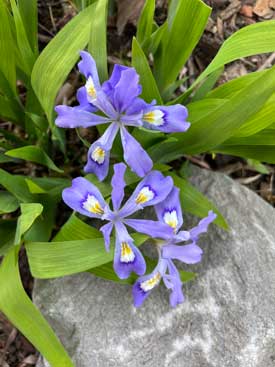
By Sarah Wilson
What if every homeowner in St Louis County (440,000+) planted one native plant? What a help that would be to our struggling Missouri wildlife! One native plant could supply food, shelter, nurseries, and needed rest stops. To further that dream, here are a few of the tough native ground covers to consider for dryer areas of your yard — areas where few things seem to thrive.
Rose Verbena (Glandularia canadensis)
This hot-pink beauty is one of the first flowers to show up in the spring then continues to put on a show for months. Can spread both by sprawling and by seed. Rabbit-resistant here; respected internet sources disagree. (I don’t have deer so cannot speak to that.)
Loved By: Butterflies | Blooms: May-August | Height: Around 6” here. | Light: Full sun to light shade. | Moisture: Dry to average.
Field Pussytoes (Antennaria neglecta)
I planted this last spring, then watched this tough little plant survive the 100+ degree heat we had with little watering. When someone put “neglect” in the name, they weren’t kidding. Do not amend the soil; pussytoes thrives in lean, dry, fast-draining dirt. Spreads vegetatively when happy. The white flowers are unusual, looking a bit like a cat’s paw, hence the name. Rabbit-resistant here.
Loved By: American Lady Butterfly which uses it for their caterpillars. | Blooms: April-June | Height: Foliage forms a short mat. Flowers on stalks 6” or so tall. | Light: Sun to Part Shade | Moisture: Average to dry.
Dwarf Crested Iris (Iris Cristata)
Blooming gloriously in April and May, these small but mighty native irises make me smile every year. They love partial shade with well-drained soil. When happy, they spread vegetatively into a lovely ground cover. Rabbit-resistant here.
Loved By: Hummingbirds | Blooms: April-May | Height: Foliage 6-8”, flowers about foliage height. | Light: Partial to almost full shade. | Moisture: Accepts a range but not super dry.
Blue Grama Grass (Bouteloua gracilis)
Six different butterflies use the small clumps of this grass as a host plant for their babies. This tough grass thrives in dry locations and lean soil. Like the Field Pussytoes, do not plant in enriched, black, “good” soil. Don’t overwater. Okay under Black Walnut. Rabbit-resistant here.
Loved By: Butterflies, birds eat the seeds. | Blooms: July-October | Height: <6” for the foliage, 12” or more for the seed heads. | Light: Sun to light shade. | Moisture: Dry (mine are on a slope)


